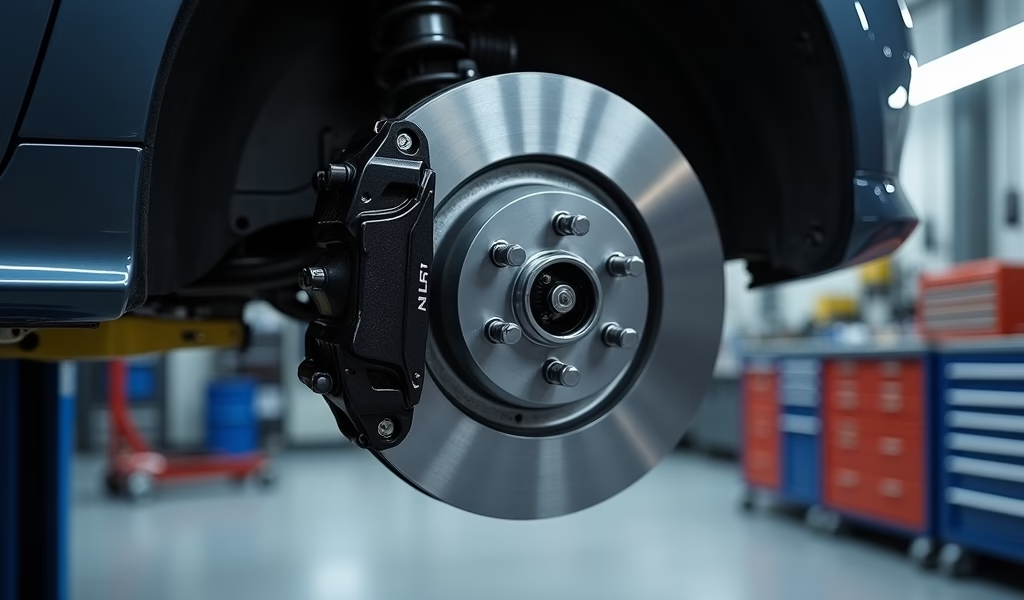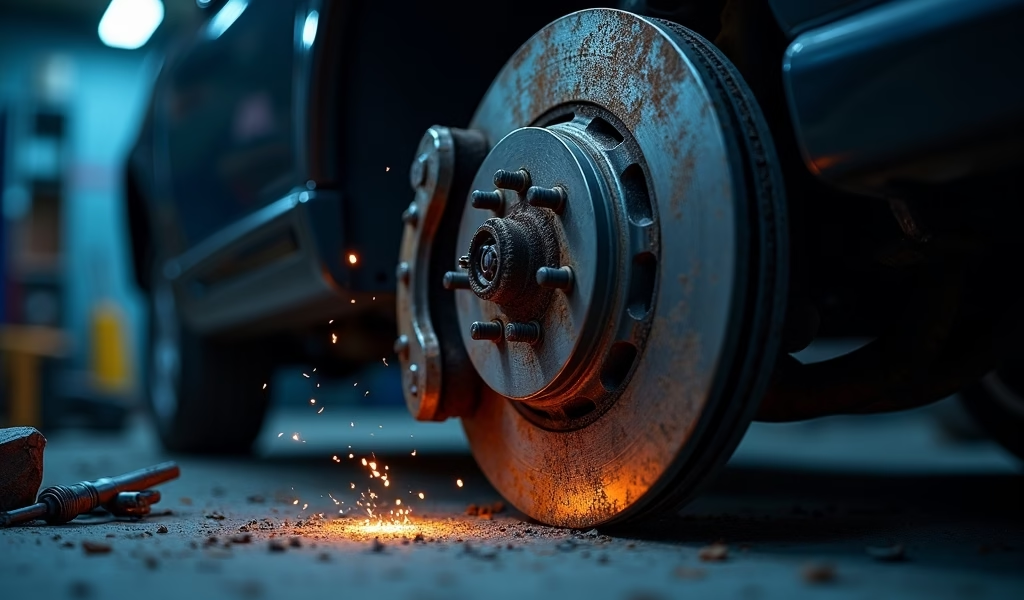Overview
Brake replacement typically costs $150-$800 per axle depending on vehicle type, required components, location, and service provider, with DIY options saving 40-60%. The article offers five key tips for managing costs: recognizing when replacement is needed, comparing quotes from multiple shops, weighing DIY versus professional installation, practicing proper maintenance to extend component life, and understanding warranty options.
Table of Contents
- Understanding Brake Replacement Cost
- Factors Affecting Brake Replacement Cost
- Average Cost Breakdown
- Tip 1: Know When to Replace Your Brakes
- Tip 2: Shop Around for Quotes
- Tip 3: Consider DIY vs. Professional Replacement
- Tip 4: Maintain Your Brakes for Longevity
- Tip 5: Understand Warranty Options
- Conclusion
- Frequently Asked Questions
Understanding Brake Replacement Cost
Let’s face it – nobody gets excited about brake replacement cost. As a mechanic with over 15 years in the business, I’ve seen countless worried faces when discussing brake work. The good news? Understanding what affects these costs can save you both money and stress. Brake replacement is one of those inevitable maintenance tasks that every vehicle owner will encounter, typically costing anywhere from $150 to $800 per axle depending on several factors.
Your vehicle’s braking system is arguably its most critical safety component. When you press that pedal, a complex system of master cylinders, brake lines, calipers, rotors, and pads works together to bring your vehicle to a safe stop. Ignoring warning signs or delaying necessary brake replacement isn’t just costly—it’s dangerous.
In this comprehensive guide, I’ll walk you through everything you need to know about brake replacement costs, including five essential tips to ensure you get quality work without breaking the bank. Whether you’re hearing that telltale squeal or just planning ahead for maintenance, understanding these costs is the first step to making informed decisions about your vehicle’s safety.
Factors Affecting Brake Replacement Cost
Several key factors influence how much you’ll pay when it’s time for new brakes. Understanding these can help you anticipate costs and even make choices that could save you money in the long run.
Vehicle make and model plays a massive role in pricing. Luxury vehicles like Mercedes-Benz or BMW typically use higher-end components that cost significantly more than parts for a Honda Civic or Toyota Corolla. For example, brake pads for a basic sedan might cost $30-60 per wheel, while luxury vehicle pads could easily exceed $100 each.
The components being replaced will dramatically impact your total bill. Are you just replacing brake pads, or do you need new rotors, calipers, or brake lines as well? A complete brake job that includes pads, rotors, and calipers will naturally cost more than a simple pad replacement.
Your geographic location matters too. Labor rates vary widely across the country, with urban areas and regions with higher costs of living typically charging more. A brake job in Manhattan will almost certainly cost more than the same work in rural Iowa.
The service provider you choose makes a difference as well. Dealerships typically charge premium rates but offer manufacturer-certified parts and technicians. Independent shops often provide competitive pricing, while chain repair facilities may offer promotions but might upsell unnecessary services. Each comes with its own price structure and potential benefits or drawbacks.

Average Cost Breakdown
Understanding the cost breakdown for brake replacement helps you evaluate quotes more effectively. Let’s break down what you can expect to pay for the various components:
Brake pads typically range from $30 to $100 per axle for standard vehicles, while premium or performance pads can cost $100-$300 per axle. This variation depends on material quality—ceramic pads cost more than semi-metallic or organic options but often last longer and produce less dust.
Rotors (also called brake discs) generally cost between $30 and $75 each for standard vehicles. High-performance or slotted/drilled rotors can easily run $100-$200+ each. Some budget-conscious drivers opt to have rotors resurfaced rather than replaced, which costs roughly $15-$25 per rotor—but this is only an option if your rotors have adequate thickness remaining.
Calipers, which clamp the pads against the rotors, are the most expensive brake component. New calipers typically cost $60-$200 each depending on your vehicle. Remanufactured options can save you some money while still providing reliable performance. Keep in mind that calipers don’t typically need replacement with every brake job.
Labor costs vary widely based on location and service provider but typically range from $80-$120 per hour. A standard brake repair job usually takes 1-3 hours per axle, so you’re looking at $80-$360 in labor alone. According to AAA’s auto repair estimates, labor accounts for roughly 40% of your total brake replacement cost.
All together, here’s what you might expect to pay for brake replacement:
- Basic brake pad replacement: $150-$300 per axle
- Brake pads and rotor replacement: $250-$500 per axle
- Complete brake job (pads, rotors, calipers): $400-$800+ per axle
Tip 1: Know When to Replace Your Brakes
Recognizing the warning signs that your brakes need attention can save you from more expensive repairs down the road. As your trusted mechanic friend, let me share the telltale indicators that should prompt you to schedule a brake inspection.
First up are the audible clues. That high-pitched squealing when you apply the brakes isn’t just annoying—it’s purposeful! Brake pads have wear indicators specifically designed to create that noise when your pads are getting thin. If you hear grinding, that’s even more serious, indicating metal-on-metal contact that’s damaging your rotors with every stop.
Physical feedback matters too. Does your brake pedal feel spongy or sink toward the floor? That could indicate air in your brake lines or failing brake components. A vibrating or pulsating brake pedal, especially during moderate to hard braking, typically signals warped rotors that need attention.
Visual cues are equally important. Most modern vehicles allow you to see your brake pads without removing the wheels—just peek through the wheel spokes. Your pads should have at least ¼ inch of material. If they’re thinner than that, replacement is needed soon. Also check for uneven pad wear, which might indicate caliper issues.
Performance changes should never be ignored. If your stopping distance has increased or your vehicle pulls to one side during braking, these are significant safety concerns that warrant immediate professional inspection, according to NHTSA safety guidelines.
Remember, most manufacturers recommend brake inspections every 10,000 to 15,000 miles, even without symptoms. Regular checks can catch issues before they become expensive problems or safety hazards.
Tip 2: Shop Around for Quotes
Getting multiple quotes for your brake replacement can save you hundreds of dollars. I’ve seen identical brake jobs priced $200 apart at shops within the same neighborhood! But there’s a right way to comparison shop that goes beyond just finding the lowest number.
Start by gathering detailed quotes from at least three different service providers: a dealership, an independent shop, and a national chain. Make sure each quote specifies exactly what’s being replaced (pads, rotors, calipers, etc.) and the quality/brand of parts being used. This apples-to-apples comparison is crucial.
When speaking with service advisors, be specific about your concerns. Describe any symptoms you’ve noticed and ask what they recommend. A good shop will explain their recommendations rather than just presenting a laundry list of parts to replace.
Don’t be shy about negotiating, especially at independent shops. If you’ve received a lower quote elsewhere for comparable work, many places will match or come close to competitors’ pricing. Some shops also offer price-matching guarantees that you can leverage.
Consider timing your brake replacement strategically. Many shops run seasonal promotions (particularly during slower periods like late winter or mid-summer) that can save you 10-20% on parts and labor. Some national chains have regular monthly specials worth watching for.
Finally, look beyond the price tag alone. A slightly higher quote from a well-reviewed shop with a solid warranty might represent better value than rock-bottom pricing from a shop with questionable reviews. Remember, properly functioning brakes are crucial for your safety.

Tip 3: Consider DIY vs. Professional Replacement
Should you tackle brake replacement yourself or leave it to the pros? As someone who’s guided countless DIYers through brake jobs, I can tell you it’s doable for many—but not without consideration.
Let’s talk savings first. DIY brake replacement typically saves 40-60% compared to professional service, primarily in labor costs. For a standard vehicle, you might spend $100-$300 on parts versus $250-$500 at a shop. That’s real money back in your pocket.
But before you rush to grab your wrench, honestly assess your mechanical abilities. Basic brake pad replacement requires moderate skills and simple tools. However, dealing with stuck calipers, bleeding brake lines, or diagnosing underlying issues demands more experience. Don’t let YouTube confidence exceed your actual abilities when it comes to safety-critical systems.
Tool requirements are another consideration. While basic hand tools might suffice for simple pad swaps, you’ll likely need specialized tools like a brake caliper compression tool, torque wrench, and potentially a bleeder kit. Factor these costs into your decision if you don’t already own them.
Time commitment matters too. What takes a professional 1-2 hours might take a first-time DIYer an entire Saturday. If your time is valuable or you’re not confident in completing the job in one session, professional service might be worth the premium.
Safety cannot be overstated. Improper brake work can lead to brake failure, which is why many DIYers compromise by handling front brake pads (which are typically simpler) themselves while leaving rear brakes or more complex work to professionals. There’s no shame in knowing your limits.
If you do decide to DIY, invest in a quality repair manual specific to your vehicle and consider having your work inspected by a professional afterward. Many shops will perform a post-DIY safety check for a nominal fee—peace of mind well worth the cost.
Tip 4: Maintain Your Brakes for Longevity
The best way to manage brake replacement cost is to extend the life of your current brakes. With proper maintenance, I’ve seen brake components last 20,000-70,000 miles or more, depending on driving conditions and habits.
Driving technique dramatically impacts brake longevity. Avoid “two-foot driving” (resting your left foot on the brake pedal while driving), which causes constant light contact between pads and rotors. Practice smooth, progressive braking rather than last-minute, hard stops that generate excessive heat and wear.
Speaking of heat, it’s your brake system’s worst enemy. When driving downhill for extended periods, use engine braking by shifting to a lower gear rather than riding your brakes continuously. This technique prevents overheating that can warp rotors and degrade brake fluid.
Regular brake fluid flushes are often overlooked but crucial. Brake fluid is hygroscopic, meaning it absorbs moisture over time. This moisture reduces braking effectiveness and corrodes internal components. Most manufacturers recommend replacing brake fluid every 2-3 years regardless of mileage.
Don’t ignore rotor care. Having rotors resurfaced (when thickness permits) during pad replacement ensures even contact and extends the life of your new pads. This typically costs $15-25 per rotor and can extend their service life significantly.
Routine inspections catch problems early. Have your brakes visually inspected at every oil change—most shops include this at no extra charge. Pay attention to unusual sounds, vibrations, or changes in brake pedal feel between inspections, as these often indicate developing issues.
Vehicle load also affects brake wear. Hauling heavy loads or towing puts additional strain on your braking system. If you regularly carry heavy cargo or tow trailers, consider upgrading to heavy-duty brake components designed for these demands.
Tip 5: Understand Warranty Options
Smart warranty choices can save you significantly on future brake work. Not all brake warranties are created equal, and knowing what to look for can protect your investment.
Most quality brake pads come with manufacturer warranties ranging from 1-3 years or 12,000-50,000 miles. Premium pads often feature longer coverage periods. The key distinction is whether the warranty covers parts only or parts and labor. The latter obviously provides much better protection against future costs.
Be aware of pro-rated versus full-replacement warranties. Pro-rated warranties reduce coverage based on use, similar to tire warranties. Full-replacement warranties offer complete replacement within the warranty period, regardless of wear. The difference can be substantial if you need replacement near the end of the warranty period.
Shop warranties deserve close attention. Many independent shops and chains offer their own service warranties that may exceed manufacturer coverage. Some national chains even offer lifetime replacement on brake pads purchased through them, though these typically require regular inspections and servicing exclusively at their locations.
Always get warranty details in writing and understand the claim process. Some warranties require original receipts, regular documented inspections, or specific maintenance procedures. Missing these requirements can void your coverage when you need it most.
Consider whether transferability matters to you. If you plan to sell your vehicle soon, a transferable warranty can be a selling point. However, most shop-specific warranties are non-transferable, tied to the original purchaser rather than the vehicle.
Finally, compare warranty value against premium costs. Sometimes paying 15-20% more for premium brake components with superior warranty coverage represents excellent value, especially if you plan to keep your vehicle for several years.
Conclusion
Understanding brake replacement cost doesn’t have to be intimidating. By recognizing the factors that influence pricing, knowing when replacement is truly necessary, shopping smartly for services, weighing DIY options, practicing good maintenance habits, and leveraging warranty protection, you can manage these inevitable expenses more effectively.
Remember that when it comes to your vehicle’s braking system, the lowest price isn’t always the best value. Quality parts installed correctly not only last longer but provide the stopping power you need when it matters most. After all, few vehicle systems are as directly tied to your safety as your brakes.
Whether you’re facing immediate brake replacement or planning for future maintenance, these five essential tips will help you navigate the process with confidence. Your wallet will thank you, and more importantly, so will everyone who rides in your safely-stopping vehicle.
Don’t wait until you hear that metal-on-metal grinding to address brake issues. Regular inspections and proactive maintenance remain your best defense against unexpected and costly brake repairs. With these insights from a mechanic who’s seen it all, you’re well-equipped to make smart decisions about your vehicle’s braking system for years to come.
Frequently Asked Questions
How often should brake pads be replaced?
Most brake pads need replacement every 30,000 to 70,000 miles depending on driving conditions and habits. City driving with frequent stopping typically requires more frequent replacement than highway driving.
Is it necessary to replace rotors with pads?
Not always, but it’s often recommended. If rotors have adequate thickness and no warping or scoring, they can sometimes be resurfaced rather than replaced.
Can I replace just the front or rear brakes?
Yes, brake replacement is typically done by axle (front or rear) as these wear at different rates. Front brakes usually wear faster as they handle 60-80% of braking force.
How long does a brake replacement take?
Professional brake replacement typically takes 1-3 hours per axle. The exact time depends on the vehicle type and components being replaced.
What are the signs that I need new brake pads?
Key indicators include squealing or grinding noises, reduced braking performance, brake pedal vibration, and warning lights. Visual inspection showing less than ¼ inch of pad material remaining is also a clear sign.

